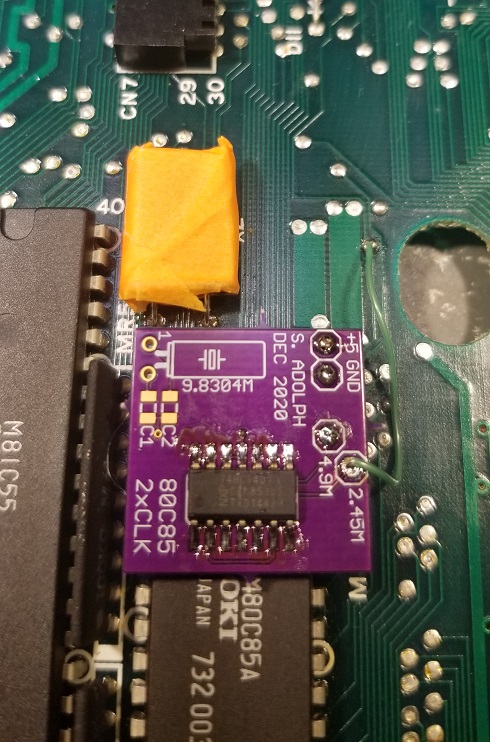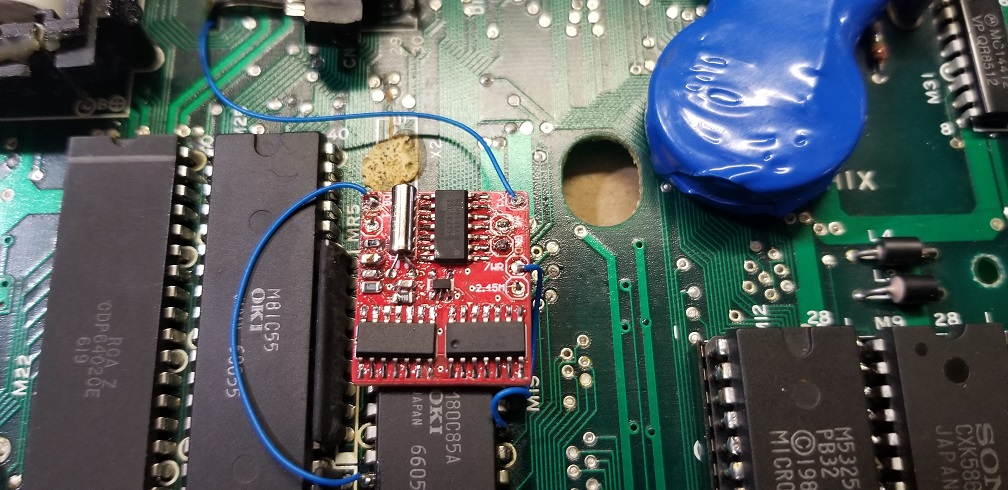5MHz Upgrade hacks
Can we speed up the Model T? Apparently!
I have been investigating various ways to make the Model T run … faster.
Initially, I started with fixed 5MHz upgrades. These are practical if you never ever want to run at 2.5MHz. But, since 5MHz operation effectively renders the cassette port unusable, a switchable design might also be nice. Switchable means that you can control the speed from BASIC.
UPDATE June 2022
I've invested some time in trying to make the simplest possible 5M upgrade for M100. M100 has a couple of issues to overcome
1) the main ROM is too slow. This is easily overcome by swapping in an EPROM. 2) on early M100s the system RAM is also (barely) too slow. Early RAM modules were 250nsec SRAM.
I now have a very nice solution that allows one to keep using the original SRAM. The solution involves modifying the A* signal that is used to enable the SRAM. By speeding it up a touch, you can use the original SRAMs (and really any M100 SRAM modules).
I'll soon be posting a much revised solution for M100. The great news is also that I've really tuned the power consumption. My test M100 had a stock current of about 50mA. Running 5MHz the current jumped to 70mA. This is a nice result, better than I have had in the past with other designs. And you are spending less power per CPU cycle.. so it is a GREEN solution! hah.
Switchable solutions
In the M100/T102, port /Y1 is free to use. So, for switchable implementations
Power up default is 2.5 MHz OUT144,0 sets to 2.5MHz OUT144,1 sets to 5MHz
Current Upgrades Status
| Computer model | Fixed 5MHz | Switchable 5MHz |
| T102 | PCBs, V1.2 instructions available | PCB available |
| M100 | PCBs, V1.1 instructions available | PCBs available |
| M100 (UK) | like M100, but no need for new EPROM | like M100, but no need for new EPROM |
| M100+NSC800 | contact me | - |
| T200 | not yet investigated | not yet investigated |
| PC-8201 | not yet investigated | not yet investigated |
| KC-85 | like M100? | like M100? |
As I test and more-or-less land on a reasonable upgrade process, I will post instruction files here If you have any questions, please get in touch with me at Twospruces at --the google mail service.
Also, since OSHPARK is so clumsy in dealing with PCB revisions (basically you can't remove a bad file design once shared), I've decided to just post PCB gerber files and schematics here. That way I can control issues that I find and always have the corrected files available.
What are the tradeoffs?
A fixed solution makes your laptop always run at 5MHz. A switchable solution gives you the option of standard operation or "TURBO mode". The switchable solution is a nice way to go. Switch up when needed, switch down when necessary.
Some of the considerations are captured below.
Laptop functionality
| Item | Fixed 5MHz | Switchable 5MHz |
| Processor speed | 5MHz | 2.5 or 5 MHz |
| LCD | 5MHz | 2.5 or 5 MHz |
| I/O | 5MHz | 2.5 or 5 MHz |
| BCR | 5MHz | 2.5 or 5 MHz |
| Cassette | assumed non functional | functional in 2.5 MHz mode |
| Modem | standard | standard |
| Printer | standard | standard |
| Power consumption | ~40% higher | ~40% higher in 5MHz mode |
Complexity of modifications
| Item | Fixed 5MHz | Switchable 5MHz |
| Clock PCB assembly ease | easiest | small SMT soldering |
| Crystal location | swap onboard | mounted on adapter board |
| Clock PCB installation ease | easiest | additional wiring |
| M100 ROM upgrade | challenging to build | challenging to build |
| M100 main PCB cut tracks? | one clock trace | one clock trace |
| T102 main PCB cut tracks? | one clock trace and RAM mod | one clock trace and RAM mod |
| Reversible? | yes, remove hack and repair cut tracks | yes, remove hack and repair cut tracks |
What about compatibility with REX#/REXCPM?
REX# and REXCPM from November 2021 are built and tested compatible with 5MHz. In fact my test station runs at 5MHz. If you have an earlier REX#/REXCPM, contact me to discuss what to do.
Instructions
Take a look at the instruction files below. Please don't try this if you are not confident of success! I welcome feedback and comments. Especially if you find errors or improvements.
Fixed 5MHz Upgrades
| Computer model | Version | Upgrade file |
| T102 | Fixed 2x upgrade V1.2 | T102 5MHz mod V1.2 Apr2 2022.pdf |
| M100 | Fixed 2x upgrade V1.1 - Note: this solution would benefit from an improvement. | M100 5MHz mod V1.1 Apr 2022.pdf |
For the M100 V1.1 upgrade above, I know have a solution that reduces power significantly. As a result I will have to post an improved design. I have an improved switchable design at this time.
For M100 with NSC800, contact me for a solution. This would of course be a dedicated CP/M machine with REXCPM installed.
Switchable 5MHz Upgrades
| Computer model | Version | Upgrade file |
| T102 | Switchable 2x upgrade V1 | design is done. working on docs |
| M100 | Switchable 2x upgrade V1 | design is done. working on docs |
PCBs
Posted here so I can maintain and update the designs, are Gerber files, layout images and schematic images.
| PCB | Version | Comments | Gerbers |
| Fixed 5MHz clock board (/2 board) | This board has no small SMT and uses main board crystal. Easiest! | V2 | Divide by 2 PCB Gerbers |
| Switchable 5MHz clock board, simplified | larger board, easier to install | V3 |
Photos
T102 with a fixed 5MHz board. This board is easy to make, and the 10M crystal is on the main board. No small SMT soldering! Note: what is shown is an early board. Latest board is more compact and eliminates the unused parts.
T102 with a switchable 5MHz board. This board has to use a crystal on the clock board, and has small SMT soldering. Harder to build, but has switchable clock.
This board is good, but there is a better solution.
FAQ
As this is tried I'm sure questions and comments will arise. We can capture useful information here. Thanks.

